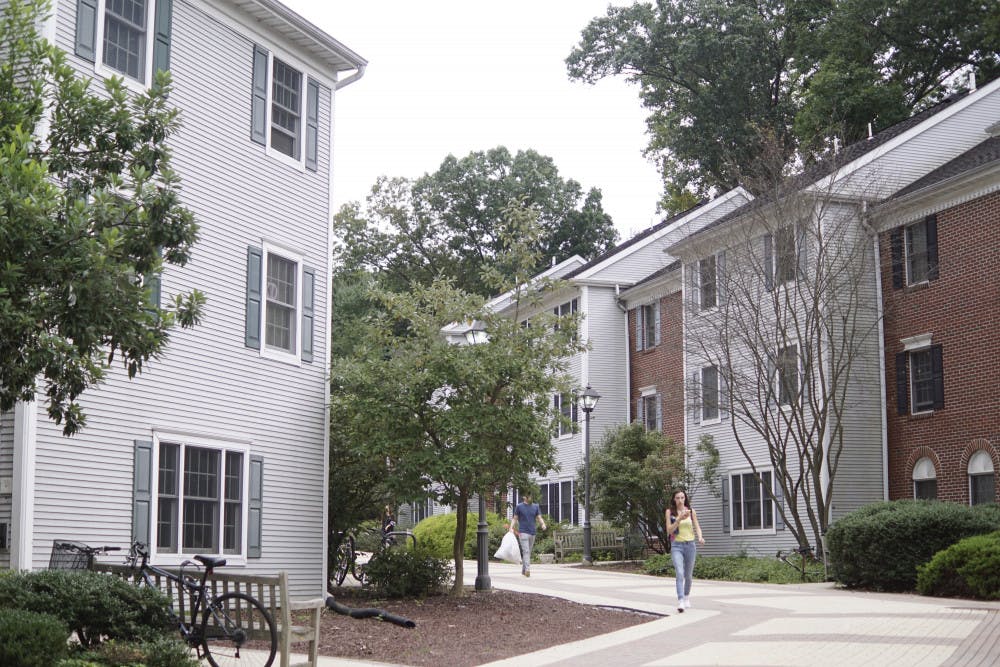By Michelle Lampariello
Editor-In-Chief
For some residents, moving into their room in Townhouses South marked their first time living without a roommate. For others, their first time with air conditioning. But for several Townhouses South residents, their arrival was not focused on new amenities or an upgraded living situation — instead, they were faced with an unexpected presence of mold in their dorm rooms and common areas.
Mold was visible on “window frames, certain wall surfaces, furniture, some clothing and other interior surfaces,” according to Luke Sacks, the College’s head media relations officer. Students also reported smelling mold-like odors.

The College has since taken steps to remove mold from the residence halls. The remediation process in each afflicted area was dependent on the amount of mold found, according to Sacks.
“Typically, mold on surfaces was removed through wet wiping methods using products specifically intended to address such growth,” Sacks said. “If there were leaks onto carpeting and similar materials, the response was to address the leak, extract and treat the carpet and the use of dehumidifiers and fans to assist with drying.”
In some instances, the College was required to replace furniture and wall surfaces, as well as re-insulate HVAC piping, according to Sacks.
While students are happy to see that steps have been taken to halt the mold’s growth and remove it from their residence hall, some are dissatisfied with the lengthy process it took to come this far.

Kevin Pilsbury, a junior international studies major, placed three work orders before the mold in his room was successfully removed.
“The first time was very thorough and I was very satisfied, but less than a week later I noticed the mold was back,” Pilsbury said. “The second work order was useless; the guy came to my room with some wet wipes and lazily wiped the side of the dresser before leaving. The last work order was even more thorough than the first one; they cleaned the carpet and every inch of the furniture in my room, even the back of pieces.”
Patikorn Trethasayuth, a junior finance major and international student who came from Thailand to study at the College, noticed “some discoloration, on his wall and furniture as soon as he moved in. However, he did not fully understand that there was mold in his room until he discussed the issue with a friend.
The presence of mold in Trethasayuth’s room caused him to experience sinus problems.
“I just knew it was hard for me to breathe, but I didn’t know what was wrong with me,” he said.

Once Trethasayuth placed a work order for the mold, an anti-mold wipe was used to clean his room. A wall in his room was cut open to fix issues with the piping, and dirt and dust were wiped out of the air conditioning unit in his residence.
Pilsbury grew frustrated with the mold’s persistent regrowth after multiple measures were taken to remove it. Some of his property was damaged as a result of the mold, despite his efforts to wipe down his belongings on a regular basis.
“The mold was on all the furniture and even on the carpets, so it felt really gross,” he said. “It got on some of my things and I even had to throw a pair of slippers and a T-shirt away.”
The College hypothesizes that the presence of mold was a result of residents leaving their windows open while the air conditioning was on or setting the temperatures on their air conditioners too low. Sacks explained that these issues also could have been a result of the air conditioner’s inability to fully dehumidify the air, which is especially problematic due to recent prolonged periods of heat, rain and humidity.
The notion that the presence of mold could be due to behaviors and habits of residents upset Pilsbury.
“There shouldn’t have been mold in the first place,” Pilsbury said. “The worst part is that they would tell me that it was because I have the window open or because I have a wet towel on my AC. Placing the blame on me when this is not a localized issue is not OK.”
Pilsbury is also frustrated that he has not received a formal apology from the College regarding the mold.
While some students were temporarily and voluntarily relocated to other rooms in the townhouse complexes or on-campus apartments while the mold was removed, Sacks stated that most affected rooms were immediately reoccupied.
Trethasayuth’s sinus issues have since resolved once the mold was removed, and the hole in his wall has been resealed. While he is happy to be feeling better, Trethasayuth recognizes the severity and widespread nature of the mold growth in Townhouses South.
“I think that it’s something that should be taken seriously and fixed,” he said.
The College will continue to respond to reports of mold on an ongoing basis, according to Sacks. The Office of Occupational Safety & Environmental Services invited an environmental consultant to review the steps taken to remove the mold and advise on future procedures.
On Oct. 1, the consultant began performing visual inspections of every room in Townhouses South and will advise the College of any measures necessary to prevent regrowth.
Brian Webb, director of risk management, and Amanda Radosti, environmental programs specialist in the Office of Occupational Safety & Environmental Services, would not comment on this issue as individuals and instead chose for the College to provide information to the media through the College’s Office of Communications, Marketing & Brand Management.







